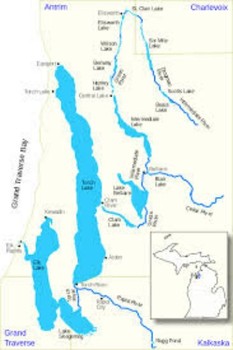 Northern Michigan must manage its waters to keep them clean and exceptional, according to scientists and watershed experts who recently met with local government officials at Camp Hayo-Went-Ha in Central Lake.
Northern Michigan must manage its waters to keep them clean and exceptional, according to scientists and watershed experts who recently met with local government officials at Camp Hayo-Went-Ha in Central Lake.
Community watershed plans should guide businesses and individuals to minimize pollution of lakes and rivers, according to speakers at the seminar, which was moderated by Haley Breniser, Executive Director of The Grass River Natural Area.
How Do Watershed Plans Help Clean Water?
“Watershed plans should address stormwater which does not soak into the ground,” explained the first speaker, Grenetta Thomassey of The Tip of the Mitt Watershed Council.
This excess stormwater is a primary cause of nonpoint source water pollution (NPS), which is defined as “pollution from many diffuse sources.”
Keeping driveways and road surfaces unpaved is helpful for stormwater management, as impervious surfaces do not allow rain to soak and infiltrate into the ground.
In addition, plants and trees are beneficial to watersheds since they help filter water. In fact, planting a natural buffer on the shoreline is the best way to help the watershed. Using rain barrels and rain gardens is also beneficial.
Dumping chemicals down storm drains, and using road salt, fertilizers and pesticides are all activities harmful to watersheds.
What is Happening with Local Watersheds?
There are many local groups working to keep area waters healthy. After all, the Elk River Chain of Lakes Watershed is the largest of the nine subwatersheds in the Grand Traverse Bay Watershed.
“The Elk River Chain of Lakes Subwatershed consists of 500 square miles, 14 lakes and rivers, and 138 miles of designated trout streams,” stated Sarah U’Ren of The Watershed Center – Grand Traverse Bay.
One project that is improving water quality is The Grass River Large Woody Debris Project, which is an experiment to determine if placement of logs may improve the river by reducing sediment buildup. Details of how this project will affect water levels were discussed by Mark Stone, Antrim County Operator of Dams and Drain Commissioner. Stone’s job was recently restructured so that he could better deal with increasing concerns of water levels and quality.
There have also been many recent changes in laws and permits related to watersheds and soil erosion, according to Heidi Shaffer of The Antrim Conservation District. “Hopefully, government attitude should not be about stopping development,” said Shaffer. “It should be about helping people figure out what they can do without hurting the environment.”
In addition, a project team in Milton Township is studying erosion and determining maintenance priorities for road ends and public access sites. This ongoing project was outlined by Chris Weinzapfel, Milton Township Zoning Administrator.
Fish Shelter Project
The Elk River Chain of Lakes Fish Shelters Project was the final topic of the day.
“Volunteers from the area lake associations have helped place natural fish habitats in 82 spots spread between five lakes,” explained Dean Branson of the Three Lakes Association. These lakes are Intermediate Lake, Clam Lake, Torch Lake, Elk Lake and Lake Bellaire.
Shelters made of hardwood slab trees have attracted big fish, according to Branson. The shelters made of hardwood crates filled with natural brush have shown to be the most effective for all fish. The GPS coordinates for these fish shelters can be found on the Three Lakes Association website.
Author’s note: The article above was previously published in the Antrim Review.
